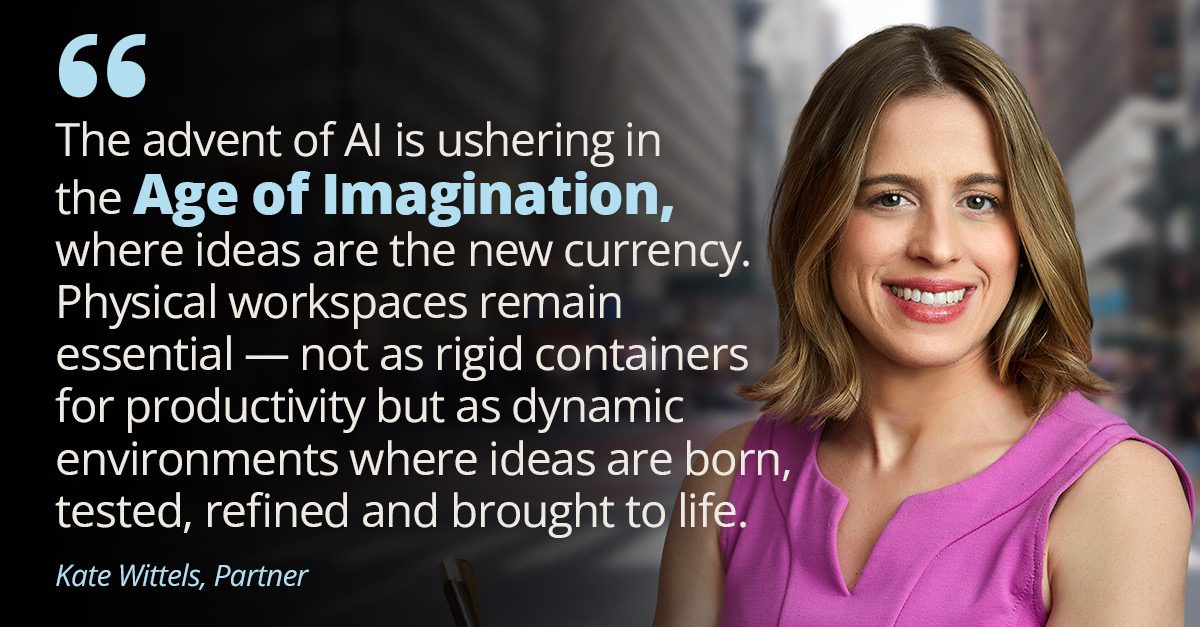on Apr 25, 2025
AI is rewriting the rules of workspaces

AI is rewriting the rules of workspaces
This op-ed was originally published by Crains New York Business.
For too long, the office has been shaped by rigid zoning laws, inflexible lease structures and outdated underwriting standards. These frameworks were designed for a world where work meant sitting in an office from 9 to 5, five days a week. That world is gone. The rise of hybrid work, AI and automation is rewriting what it means to work.
We built workspaces to produce — that meant assembling cars in the Industrial Age or crunching numbers in the Information Age. The advent of AI is ushering in the Age of Imagination, where ideas are the new currency. Physical workspaces remain essential — not as rigid containers for productivity but as dynamic environments where ideas are born, tested, refined and brought to life.
As AI gets more powerful, it will drive us to have more and more digital “colleagues.” And as we spend more of the workday interacting in the virtual world, we will need the office to reinforce “Going to work” has always been more than a job; it’s a human experience. It’s where diverse perspectives collide, unexpected friendships form, and ideas take shape. And these moments don’t just happen at a desk — they happen on the way there, too. A packed subway ride, a quick stop at the bodega, a nod to the same stranger on the sidewalk each morning — these small, everyday interactions tether us to the pulse of a city. They remind us that work isn’t just about efficiency; it’s about being human.
As William Whyte argued in The Social Life of Small Urban Spaces, the most vibrant environments are those that facilitate these informal encounters, encouraging human connection and creativity. And that human connection must be strengthened by the physical office, driving better products, smarter strategies, and stronger businesses. In the Age of Imagination, work won’t be confined to four walls. It won’t be about working more; it will be about working better, in spaces designed for the full spectrum of human potential. To do this we will need a built environment that keeps pace with the world around it. Office spaces that flex with human needs.
Construction systems that prioritize speed and reconfiguration over demolition. Policies that enable cities to adapt in real-time, shifting alongside economic and technological forces. Imagine a city where workspaces transform as quickly as ideas — where architecture and public policy isn’t a limitation, but a catalyst for progress.
Technology is outpacing our commercial office districts, but it doesn’t have to outmatch them. Consider Hudson Yards: When its master plan was released in 2003, the first iPhone was still four years away. That’s how fast the world changes. City builders — architects, policymakers, developers, bankers and builders — must embrace change.
We need zoning laws that allow for flexible office spaces that can adapt to shifting workforce needs. Lease structures should accommodate the ebb and flow of hybrid work, rather than locking companies into long-term commitments that no longer make sense. Underwriting standards must support adaptability, recognizing that commercial real estate success is no longer about filling floors with desks but about creating dynamic, multi-use environments.
But flexibility alone won’t cut it. We need to ask bigger questions. How will city grids handle AI’s skyrocketing energy demands? Will we have more retail and leisure activities if work requires less in-person, human labor? Can we redesign education and workforce training to focus on how we ideate, collaborate and leverage AI?
The question isn’t whether the office will survive AI — it’s how boldly we shape it to thrive in the Age of Imagination. If we get this right, AI won’t replace the office — it will elevate it, unlocking new opportunities for connection, creativity and prosperity. The future isn’t about diminishing physical offices; it’s about imagining environments that are more human—spaces that breathe, evolve and become essential in shaping the realities to come.
Kate Wittels is a partner at HR&A Advisors, an economic development and public policy consulting firm, and an adjunct professor at Columbia University.
Angelica Trevino Baccon is a principal at SHoP Architects.